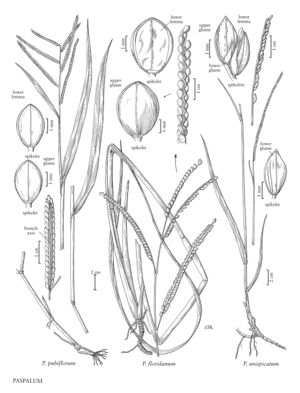Paspalum pubiflorum
Plants perennial; usually decumbent, rooting at the nodes. Culms 30-130 cm, decumbent; nodes glabrous or pubescent. Sheaths glabrous or pubescent; ligules 1-3.2 mm; blades to 31 cm long, 4-18 mm wide, flat, glabrous, with a few hairs behind the ligules. Panicles terminal, with 2-7 racemosely arranged branches; branches 2.2-7.9 cm, divergent to spreading, terminating in a spikelet; branch axes 1.1-2.3 mm wide, narrowly winged, glabrous, margins scabrous. Spikelets 2.8-3.6 mm long, 1.5-2 mm wide, paired, imbricate, appressed to divergent from the branch axes, elliptic to obovate, pubescent or glabrous, light-brown to stramineous. Lower glumes absent; upper glumes and lower lemmas glabrous or sparsely pubescent, hairs shorter than 0.1 mm, 3-veined, margins entire; lower lemmas lacking ribs over the veins; upper florets stramineous. Caryopses 1.8-2 mm, golden brown or white. 2n = 60, ca. 64.
Distribution
Md., Kans., Okla., Colo., Miss., Tex., La., W.Va., Pa., Mo., Ohio, Ala., D.C., Tenn., N.C., S.C., Va., Ark., Ill., Ga., Ind., Ky., Fla.
Discussion
Paspalum pubiflorum grows on the edges of forests and in disturbed areas. It is native to the southeastern United States, Mexico, and Cuba.
Selected References
None.
Lower Taxa
"decumbent" is not a number.
